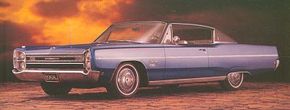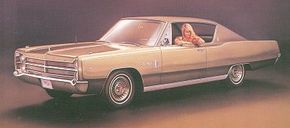Having crawled up from the depths of 1962 to new sales heights in three short years, Chrysler's bread-and-butter brand pulled out all the stops for 1967. One of the highlights was the 1967-1968 Plymouth Sport Fury and VIP.
"Plymouth is out to win you over," said the ads, and they didn't lie. Barracuda was beautifully recast as a true "ponycar" competitor for Ford's Mustang, the compact Valiant was just as handsomely transformed, and even the intermediate Belvederes, still basically 1962 underneath, were spruced up in both style and power.
Advertisement
The same applied to the pride of the Plymouth pack, the big Fury, which became even bigger for 1967. Though wheelbases and basic structure were 1965-1966 holdovers, a complete reskin upped overall length 3.3 to 7.5 inches, and more sculptured lower-body styling made the cars look even longer than that.
They also looked broader of beam, thanks partly to flared-out front fendertops and expansive new horizontal taillamps, but overall width was, in fact, an inch or so slimmer. Observing a popular Detroit trend, rear fenders were slightly upswept just ahead of the wheel openings.
The Plymouth VIP returned from its 1966 debut as the finest Fury, still with hardtop coupe and sedan styles. Right alongside them, at near identical prices, were the bucket-seat Sport Fury convertible and a pair of two-door hardtops, as Plymouth now offered a choice of hardtop coupe rooflines: a conventional notchback (duplicated in bench-seat Fury III trim) with tapered C-pillars, and a new "Fast Top" style with the same profile but big triangulated quarters that made magnificent obstructions for parking and lane-changing.
Though it looked racier, the Fast Top was the style chosen for the luxury VIP, perhaps because those huge C-pillars conferred a tad more "formality"; they certainly better displayed the optional vinyl roof coverings.
Find more details on the 1967-1968 Plymouth Sport Fury and VIP on the next page.
For more information on cars, see:
- Classic Cars
- Muscle Cars
- Sports Cars
- Consumer Guide New Car Search
- Consumer Guide Used Car Search
Advertisement

